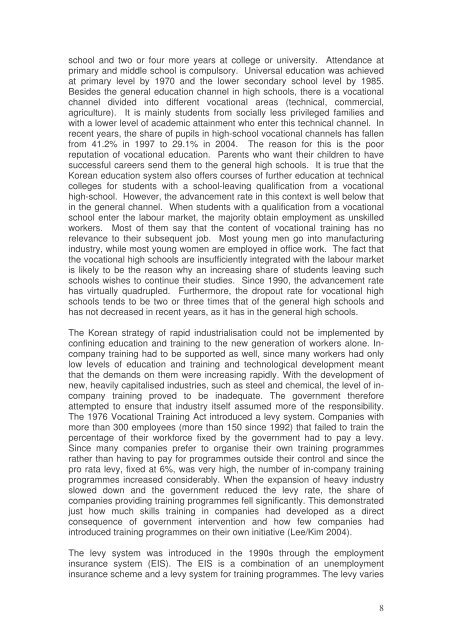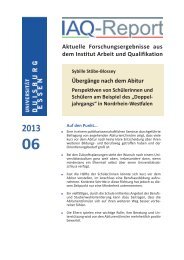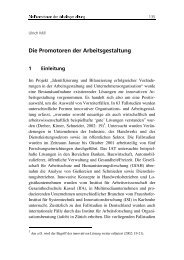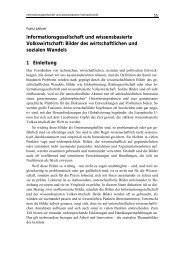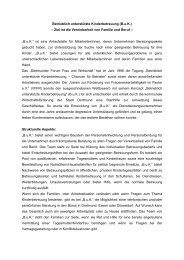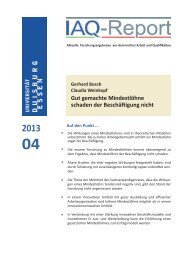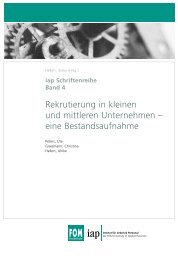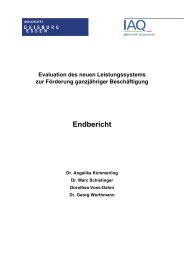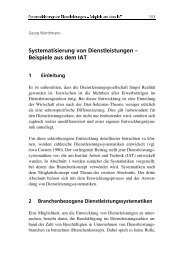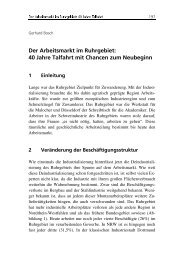1 Vocational training systems in ten countries and the influence of ...
1 Vocational training systems in ten countries and the influence of ...
1 Vocational training systems in ten countries and the influence of ...
Create successful ePaper yourself
Turn your PDF publications into a flip-book with our unique Google optimized e-Paper software.
school <strong>and</strong> two or four more years at college or university. At<strong>ten</strong>dance at<br />
primary <strong>and</strong> middle school is compulsory. Universal education was achieved<br />
at primary level by 1970 <strong>and</strong> <strong>the</strong> lower secondary school level by 1985.<br />
Besides <strong>the</strong> general education channel <strong>in</strong> high schools, <strong>the</strong>re is a vocational<br />
channel divided <strong>in</strong>to different vocational areas (technical, commercial,<br />
agriculture). It is ma<strong>in</strong>ly students from socially less privileged families <strong>and</strong><br />
with a lower level <strong>of</strong> academic atta<strong>in</strong>ment who enter this technical channel. In<br />
recent years, <strong>the</strong> share <strong>of</strong> pupils <strong>in</strong> high-school vocational channels has fallen<br />
from 41.2% <strong>in</strong> 1997 to 29.1% <strong>in</strong> 2004. The reason for this is <strong>the</strong> poor<br />
reputation <strong>of</strong> vocational education. Parents who want <strong>the</strong>ir children to have<br />
successful careers send <strong>the</strong>m to <strong>the</strong> general high schools. It is true that <strong>the</strong><br />
Korean education system also <strong>of</strong>fers courses <strong>of</strong> fur<strong>the</strong>r education at technical<br />
colleges for students with a school-leav<strong>in</strong>g qualification from a vocational<br />
high-school. However, <strong>the</strong> advancement rate <strong>in</strong> this context is well below that<br />
<strong>in</strong> <strong>the</strong> general channel. When students with a qualification from a vocational<br />
school enter <strong>the</strong> labour market, <strong>the</strong> majority obta<strong>in</strong> employment as unskilled<br />
workers. Most <strong>of</strong> <strong>the</strong>m say that <strong>the</strong> con<strong>ten</strong>t <strong>of</strong> vocational <strong>tra<strong>in</strong><strong>in</strong>g</strong> has no<br />
relevance to <strong>the</strong>ir subsequent job. Most young men go <strong>in</strong>to manufactur<strong>in</strong>g<br />
<strong>in</strong>dustry, while most young women are employed <strong>in</strong> <strong>of</strong>fice work. The fact that<br />
<strong>the</strong> vocational high schools are <strong>in</strong>sufficiently <strong>in</strong>tegrated with <strong>the</strong> labour market<br />
is likely to be <strong>the</strong> reason why an <strong>in</strong>creas<strong>in</strong>g share <strong>of</strong> students leav<strong>in</strong>g such<br />
schools wishes to cont<strong>in</strong>ue <strong>the</strong>ir studies. S<strong>in</strong>ce 1990, <strong>the</strong> advancement rate<br />
has virtually quadrupled. Fur<strong>the</strong>rmore, <strong>the</strong> dropout rate for vocational high<br />
schools <strong>ten</strong>ds to be two or three times that <strong>of</strong> <strong>the</strong> general high schools <strong>and</strong><br />
has not decreased <strong>in</strong> recent years, as it has <strong>in</strong> <strong>the</strong> general high schools.<br />
The Korean strategy <strong>of</strong> rapid <strong>in</strong>dustrialisation could not be implemented by<br />
conf<strong>in</strong><strong>in</strong>g education <strong>and</strong> <strong>tra<strong>in</strong><strong>in</strong>g</strong> to <strong>the</strong> new generation <strong>of</strong> workers alone. Incompany<br />
<strong>tra<strong>in</strong><strong>in</strong>g</strong> had to be supported as well, s<strong>in</strong>ce many workers had only<br />
low levels <strong>of</strong> education <strong>and</strong> <strong>tra<strong>in</strong><strong>in</strong>g</strong> <strong>and</strong> technological development meant<br />
that <strong>the</strong> dem<strong>and</strong>s on <strong>the</strong>m were <strong>in</strong>creas<strong>in</strong>g rapidly. With <strong>the</strong> development <strong>of</strong><br />
new, heavily capitalised <strong>in</strong>dustries, such as steel <strong>and</strong> chemical, <strong>the</strong> level <strong>of</strong> <strong>in</strong>company<br />
<strong>tra<strong>in</strong><strong>in</strong>g</strong> proved to be <strong>in</strong>adequate. The government <strong>the</strong>refore<br />
attempted to ensure that <strong>in</strong>dustry itself assumed more <strong>of</strong> <strong>the</strong> responsibility.<br />
The 1976 <strong>Vocational</strong> Tra<strong>in</strong><strong>in</strong>g Act <strong>in</strong>troduced a levy system. Companies with<br />
more than 300 employees (more than 150 s<strong>in</strong>ce 1992) that failed to tra<strong>in</strong> <strong>the</strong><br />
percentage <strong>of</strong> <strong>the</strong>ir workforce fixed by <strong>the</strong> government had to pay a levy.<br />
S<strong>in</strong>ce many companies prefer to organise <strong>the</strong>ir own <strong>tra<strong>in</strong><strong>in</strong>g</strong> programmes<br />
ra<strong>the</strong>r than hav<strong>in</strong>g to pay for programmes outside <strong>the</strong>ir control <strong>and</strong> s<strong>in</strong>ce <strong>the</strong><br />
pro rata levy, fixed at 6%, was very high, <strong>the</strong> number <strong>of</strong> <strong>in</strong>-company <strong>tra<strong>in</strong><strong>in</strong>g</strong><br />
programmes <strong>in</strong>creased considerably. When <strong>the</strong> expansion <strong>of</strong> heavy <strong>in</strong>dustry<br />
slowed down <strong>and</strong> <strong>the</strong> government reduced <strong>the</strong> levy rate, <strong>the</strong> share <strong>of</strong><br />
companies provid<strong>in</strong>g <strong>tra<strong>in</strong><strong>in</strong>g</strong> programmes fell significantly. This demonstrated<br />
just how much skills <strong>tra<strong>in</strong><strong>in</strong>g</strong> <strong>in</strong> companies had developed as a direct<br />
consequence <strong>of</strong> government <strong>in</strong>tervention <strong>and</strong> how few companies had<br />
<strong>in</strong>troduced <strong>tra<strong>in</strong><strong>in</strong>g</strong> programmes on <strong>the</strong>ir own <strong>in</strong>itiative (Lee/Kim 2004).<br />
The levy system was <strong>in</strong>troduced <strong>in</strong> <strong>the</strong> 1990s through <strong>the</strong> employment<br />
<strong>in</strong>surance system (EIS). The EIS is a comb<strong>in</strong>ation <strong>of</strong> an unemployment<br />
<strong>in</strong>surance scheme <strong>and</strong> a levy system for <strong>tra<strong>in</strong><strong>in</strong>g</strong> programmes. The levy varies<br />
8


